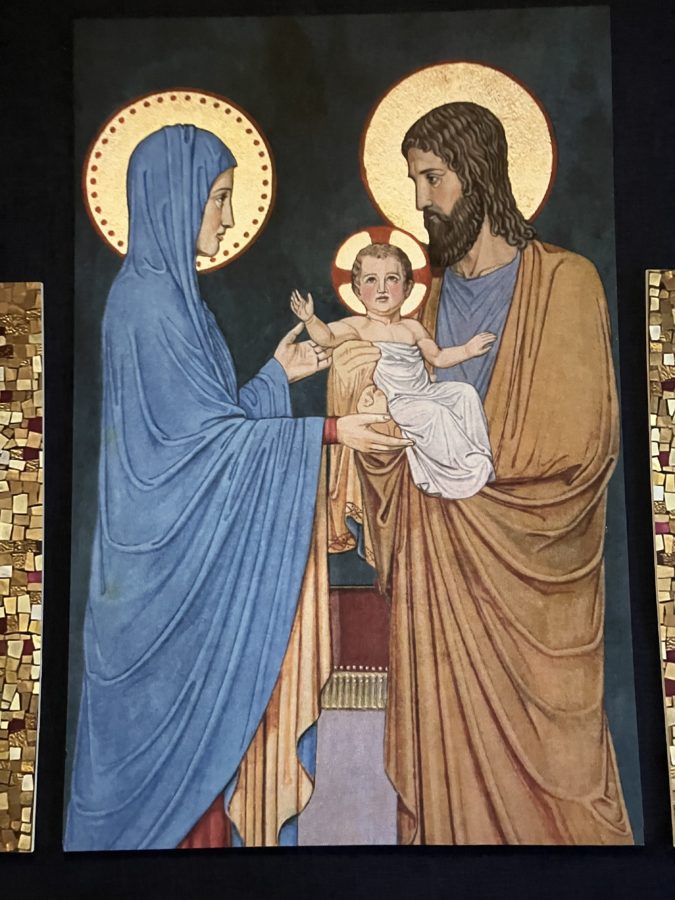The Sacraments of Faith
A mural of the Holy Family- Jesus, Mary, and Joseph- hung outside the Guadalupe Chapel in the Cathedral of Christ the King in Lexington, KY.
One of the greatest separations between Catholic and Protestant teaching is that of the sacraments. Catholicism is a sacramental faith. “Sacramental” means,“outward signs of inward grace” as instituted by Jesus Christ during his earthly ministry for the purpose of our sanctification. The sacraments are all present within scripture, which means that Protestants also practice the majority of them, though not with the same understanding.
The main difference in sacramental theology between Catholics and Protestants is this: the giving of grace is not separate from the physical action, as many Protestants believe. For example, most denominations believe that salvation is marked by an inward choice to follow God. Though believers should be baptized afterward, the baptism is a mere symbol of the inward cleansing that had already taken place. Too often this falls into the heresy of Gnosticism—a belief that anything physical is bad, and anything spiritual is good. In the Protestant understanding of baptism where the act of submersion is seen as a mere symbol, any physical action is essentially counted as unnecessary for salvation. Salvation is an inward decision and physical actions do not in any way contribute to receiving that grace, therefore the spiritual world helps people get to heaven and the physical world doesn’t. Our physical reality can be tossed out the window as immaterial, or even detrimental, to our faith lives. The sacramental understanding of baptism is that it is a visible reality of something that is happening within that moment inwardly. That the physical actions and spiritual graces are intrinsically connected in their administration.
This is not to say that God’s grace never moves without physical actions proving it, or that we are saved by our own works rather than “by grace, through faith” (Ephesians 2:8-9). Rather, what it does is acknowledge that God made us with physical form and that our faith includes physical works as well to aid us, and make us not just Christians inwardly, but in all our outward works too. It also brings to mind the great mystery of the Incarnation, that God, the Living Word, took on Flesh as wholly divine yet sharing in our humanity and, in that, completely sanctifying our physical humanity.
Sacraments of Initiation
The first type of sacrament is those of initiation into the Church. These are Baptism, Confirmation, and the Eucharist. Baptism is the sacrament most widely practiced throughout Christianity, as Jesus Christ himself was baptized by John the Baptist and proceeded to preach its importance throughout his ministry. In Christ’s baptism, though he was without sin and did not need it, we are able to see a glimpse of what happens invisibly when we, who are with sin, are baptized. The Gospel of Matthew, 3:16-17 reads, ‘” 16 As soon as Jesus was baptized, he went up out of the water. At that moment heaven was opened, and he saw the Spirit of God descending like a dove and alighting on him. 17 And a voice from heaven said, “This is my Son, whom I love; with him, I am well pleased.”
From the moment of Christ’s baptism, the heavens opened, and the Holy Spirit descended upon him. This was intended not only as a sign of his own Divinity but also as an example for our understanding. Through baptism, we wash away the eternal effects of Original Sin and are open to God’s grace. We, too, have an open heaven above us.
The sacrament of Confirmation reflects the outpouring of the Holy Spirit at Pentecost when the disciples received tongues of fire upon their heads and went out and preached in languages they did not know. It is a deepening of the outpouring of grace as it is a call to action. The baptized, now of the age of reason and able to minister to others, are strengthened with the gifts necessary to serve the Church where they are called to. This site is also practiced within the Anglican, Lutheran, and Methodist Churches.
The Eucharist, meaning “thanksgiving,” is “the source and summit of the Christian life,” according to the United States Conference of Catholic Bishops. It is also one of the greatest differences between Catholics and Protestants because Catholics believe in transubstantiation. This means that the bread and wine of communion physically become the Body and Blood of Jesus Christ, also containing his soul and divinity, having a deep and life-giving effect on the soul when it is partaken of. This is in keeping with the scriptures, the other sacraments, and the teachings of the Church Fathers. St Ignatius of Antioch, born less than 20 years after the death and resurrection of Christ, wrote about the Eucharist in his letters. He said, “I have no taste for corruptible food nor for the pleasures of this life. I desire the bread of God, which is the flesh of Jesus Christ, who was of the seed of David; and a drink, I desire his blood, which is love incorruptible” (Letter to the Romans 7:3 [A.D. 110]). And again, in his letter to the Smyrneans, “They abstain from the Eucharist and from prayer because they do not confess that the Eucharist is the flesh of our Savior Jesus Christ, flesh which suffered for our sins and which that Father, in his goodness, raised up again. They who deny the gift of God are perishing in their disputes.”
Sacraments of Healing
There are two sacraments of healing: Penance and the Anointing of the Sick.
Penance, sometimes also known as Reconciliation or Confession, is a prayerful sacrament in which a sinner comes face to face with God, acting through His priest who has been commissioned with the same authority He gave to the apostles on the day of Christ’s ascension into heaven. Matthew 16:19 says, “And I will give to thee the keys of the kingdom of heaven. And whatsoever thou shalt bind upon earth, it shall be bound also in heaven: and whatsoever thou shalt loose on earth, it shall be loosed also in heaven?”
While nobody disputes this authority was given to the disciples, it also remains true that it was multiple generations from the time of their ministry until when the Biblical canon was put together. The Jewish understanding, and indeed, the understanding the conditions necessitated, was that Paul and the others would, with their God-given authority, commission others to go out then, having been educated properly in the faith, and minister to others. These people would also be granted authority because they have been “bound” on earth into that authority, and thus “bound” in heaven. Furthermore, with the outpouring of grace on the disciples, they were not permitted to make a choice so greatly erring in their authority. As their authority came from God, so all of their authoritative choices were in conjunction with God’s Will.
The disciples were also given the authority to “loose” sins, meaning to forgive them through the authority God gave them. This gift did not die out with the apostles, but rather it was established by them to carry on in apostolic succession to our time and beyond. In the sacrament of Penance, one can confess their sins and come back into unity with God, so long as they are truly penitent and honest in their confession. It creates a necessity for honest reflection and an open vulnerability with God, so that the sinner does not hide, but also so that they may be certain in the fact that they are forgiven.
Throughout Jesus’ ministry, he laid hands on the sick and dying and showed compassion, healing them and bringing God’s mercy upon them. This appears today in the Anointing of the Sick. Again, Jesus’ signs and wonders were meant to work as visual examples of what happens spiritually when receiving God’s grace. In the Anointing of the Sick, one in a grave condition is ministered to by a priest in the hopes of physical healing, but with the expectation of spiritual healing and peace in the case of death.
Sacraments of Service
The two sacraments of service are Marriage and Holy Orders. The Church is often called the Bride of Christ and is called in the same way as a bride and groom to serve and love each other. Both of these sacraments, also referred to as ‘vocations,’ when discussing to which one is called, help actualize that idea of service to God and each other in our lives.
In the Sacrament of Marriage, “the couple witnesses Christ’s spousal love for the Church” (USCCB) and deeply partakes in it. It is more than a covenant binding two souls inextricably together for the length of their earthly lives. It is a show of sacrifice, giving up certain freedoms for the sake of love and unity and in that sacrifice, finding more joy than before.
The Sacrament of Holy Orders refers to the calling of priests, nuns, monks, and consecrated celibates. Although all Christians have been baptized “priest, prophet, and king,” it is still necessary to acknowledge that the role of the king still exists in a societal way, as does the prophet and the priest. Those in holy orders take vows of celibacy and poverty, so that their lives may be dedicated to the service of the Church and Her people. Priests are the earthly husbands of the Church, called to serve and maintain her. Nuns and monks do not serve in an authoritative role, but they stand as living witnesses to the Gospel and serve the Church through prayer and humble tasks such as teaching, healthcare, or making goods to support themselves.
They can also participate in the spousal love Christ has for the Church, but rather than being wed to a figure of Christ, or a figure of the Church; they have a calling to be wed to Christ or the Church.
In conclusion, each sacrament is a monumental meeting between God and Man that changes the soul and is visible externally. Each is geared towards the formation of the faithful and is based on Scripture and the way the Tradition of the Church teaches to live it out.

Claire Cornett is a junior at Lafayette interested in student-led stories and events. She's involved in choir and history club. She is also heavily involved...











